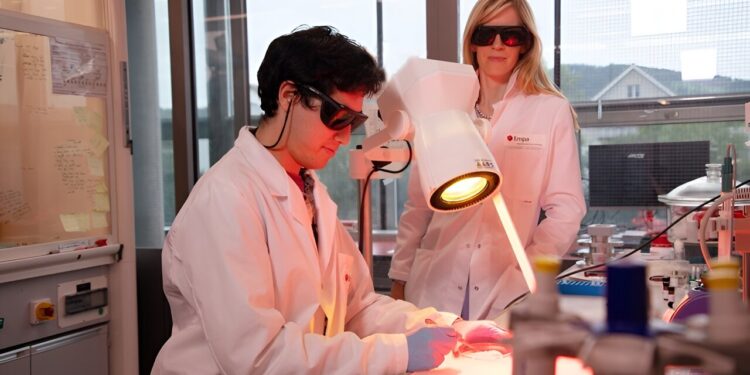Welding wounds with nanoparticle paste and light: Oscar Cipolato and Inge Herrmann in the Particle-Biology Interactions laboratory at Empa in St. Gallen. Credit: Empa
Not all wounds can be closed with a needle and thread. Empa researchers have developed a welding process with nanoparticles that gently fuses tissues together. The welding technique should prevent impaired wound healing and life-threatening complications due to leaking sutures.
The team recently published the promising method in the journal Small methods and filed a patent.
More than 5,000 years ago, humanity came up with the idea of suturing a wound with a needle and thread. Since then, this surgical principle has not changed much: depending on the sensation of the operator’s fingertips and the equipment, cuts or tears in tissue can be joined more or less perfectly. Once both sides of a wound are securely attached to each other, the body can begin to close the tissue space permanently and naturally.
However, suturing does not always achieve the desired effect. In very soft tissue, the wire can cut the tissue and cause additional injury. And if wound closure doesn’t seal the internal organs, leaky sutures can pose a life-threatening problem. Researchers from Empa and ETH Zurich have now found a way to weld wounds together using lasers.
Control temperature in real time
Soldering generally involves joining materials together using heat via a flux bonding agent. The fact that this thermal reaction must remain within narrow limits for biological materials and that at the same time the temperature is difficult to measure non-invasively has posed a problem for the application of soldering processes in medicine.
The team led by Oscar Cipolato and Inge Herrmann from the Laboratory Biological Interactions of Particles at Empa in St. Gallen and the Laboratory for Nanoparticle Systems Engineering at ETH Zurich therefore tinkered with an intelligent wound closure system in which laser soldering can be controlled smoothly and efficiently. To do this, they developed a bonding agent with metal and ceramic nanoparticles and used nanothermometry to control the temperature.
The elegance of the new soldering process also relies on the interaction of the two types of nanoparticles in the protein-gelatin bonding paste. As the paste is laser irradiated, titanium nitride nanoparticles convert the light into heat. The specially synthesized bismuth vanadate particles in the paste, meanwhile, act like tiny fluorescent nano-thermometers. They emit light of a specific wavelength depending on temperature, allowing extremely precise temperature regulation in real time.
This makes the method particularly suitable for use in minimally invasive surgery, as it does not require shaking and determines temperature differences with extremely fine spatial resolution in superficial and deep wounds.
Soft IR
Once the team optimized the iSoldering conditions via in silico mathematical modeling, the researchers were able to study the performance of the composite material. In collaboration with surgeons from the University Hospital Zurich, the Cleveland Clinic (USA) and the Czech Charles University, the team achieved rapid, stable and biocompatible wound bonding on organs such as the pancreas or liver in laboratory tests with various tissue samples.
Sealing particularly difficult pieces of tissue, such as the urethra, fallopian tubes or intestine, using iSoldering was equally successful and gentle. A patent application has now been filed for the nanoparticle-based composite material.
But the researchers didn’t stop there. They successfully replaced the laser light source with softer infrared (IR) light. This brings welding technology one step closer to its use in hospitals. “If medically approved IR lamps were used, the innovative welding technology could be used in conventional operating rooms without additional laser protection measures,” explains Empa researcher Inge Herrmann.
More information:
Oscar Cipolato et al, Intelligent laser welding of tissues by nanothermometry, Small methods (2023). DOI: 10.1002/smtd.202300693
Provided by the Swiss Federal Laboratories for Materials Science and Technology
Quote: Soldering wounds with light and nano thermometers (January 16, 2024) retrieved on January 16, 2024 from
This document is subject to copyright. Apart from fair use for private study or research purposes, no part may be reproduced without written permission. The content is provided for information only.



